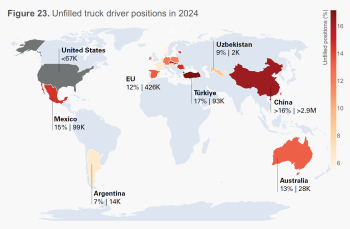- Global truck driver shortage flat at 3.6 million (in 36 countries)
- Age gap widens further: young drivers down 5.8%, older drivers up 1.6%
- 3.4 million drivers will retire by 2029
- Salaries and job satisfaction remain high
IRU’s latest global truck driver shortage report is out. While unfilled positions in 2024 were similar to 2023 due to easing transport demand, alarming figures show a widening age chasm between young and older driver employment rates. But salaries and job satisfaction remain high.
IRU’s 2024 global truck driver shortage report has found that 3.6 million positions remain unfilled in 36 countries studied representing 70% of global GDP. This is a similar level to 2023, primarily due to easing transport demand over that period.

The report however reaffirms that the shortage of truck drivers is a long-term structural issue that persists in all regions. Of 5,100 trucking firms surveyed in 2024, up to 70% in some countries face severe or very severe difficulties in recruiting drivers.
Widening age chasm
Underlying structural demographic trends are increasingly alarming, notably a widening chasm between younger and older drivers.
Young drivers under 25 make up 6.5% of the total driver workforce.1 Some countries have critically low rates, including Italy and Germany at 2.2% and 2.6% respectively. Poland and Spain are not much better at 3% each.
Unfortunately, the trend is downward. The percentage of young truck drivers compared to all drivers fell by 5.8% from 2023 to 2024.2 This is despite the reverse trend being witnessed in the overall workforces of the countries studied, with young workers up by 1.4%.3

Ticking demographic timebomb
In stark contrast, the share of truck drivers who are over 55 is 31.6%. Countries with very high percentages of older drivers include Spain at 50%, Australia at 47%, and Italy at 45%.
The trend here is also alarming. In line with overall labour force participation rates for this age group, the percentage of truck drivers who are over 55 has increased by 1.6% in the past year. The average truck driver age globally has now crept up to 44.5.4
Over the next five years, the report forecasts that 3.4 million truck drivers will retire in the countries studied. In Australia, 21% of current drivers will have retired by 2029. In China it is 18%; in Europe 17%.
For Australia and several European countries, notably Germany, Italy, Slovakia and Spain, the widening structural gap between younger and older drivers is particularly acute.
IRU Secretary General Umberto de Pretto said, “The truck driver shortage crisis continues to deepen with, most alarmingly, an ever-widening chasm between young and older drivers.
“Without concerted and continuing action, this demographic timebomb will explode, seriously impacting economic growth and competitiveness across the globe.”
Salaries and satisfaction
Salaries are often cited as a key reason for driver shortages, yet the data disproves this. Average truck driver salaries are 30-135% higher than the base cost of living level in all regions. Driver salary levels do not correlate with driver shortage levels.
On job satisfaction, IRU partnered with Truckfly by Michelin to survey 1,100 truck drivers in seven major European markets. This barometer analysed satisfaction by country, age, gender, type and size of company, and route distance.
An impressive 81% of truck drivers are satisfied with their job, with 57% being very or extremely satisfied. British, French and Italian drivers are the most satisfied. Young drivers under 25 were the age group with the highest levels of job satisfaction.
The biggest issues that drivers want fixed? 91% cited access to well-equipped rest areas and treatment at delivery sites. Gender and age did not affect this ranking.
Umberto de Pretto added, “There isn’t one magic bullet to solve the crisis, but this report points towards key solutions to start closing the widening age gap and treating drivers with more respect and dignity.
“Young working drivers are very satisfied: the issue is therefore not retention but improving access to the driver profession and its attractiveness, especially to young people.
“Governments therefore need to better integrate professional driver career pathways into educational systems, also removing unrealistic age thresholds for training and qualification, and to invest more in safe and well-equipped parking and rest areas.”
The 150-page report has detailed breakdowns by driver age, gender, country, company size, route length and international vs domestic operations. It includes sections on the economic outlook for road transport operators; detailed driver job satisfaction, accessibility and attractiveness analysis; and attraction and retention solutions for transport operators.
The driver barometer survey, included in the main report, is also available as a stand-alone report.
